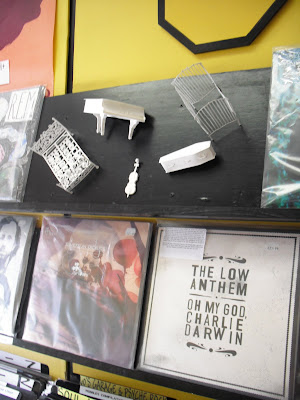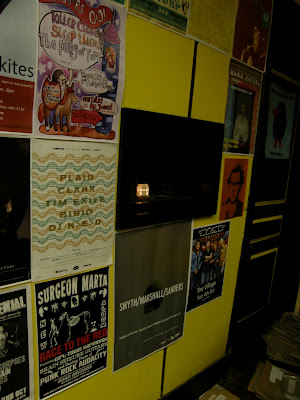January 12, 2010
Review by Sarah Lincoln
November 26, 2009
John Jones
The chinoiserie of Bewley's provides the perfect backdrop for the geometric drawings of John Jones. Created on A2 graph paper, the final piece is the accumulation of many small marks with the finished product in this instance resembling the patterns on eastern textiles. Constrained by the formality of the pre-printed lines on the paper, they recreate the illusion of symmetry and harmony where it may not necessarily be.
November 10, 2009
Paul Hickey

Paul Hickey’s interventions brighten otherwise banal areas in the urban environment. Unexpected colour bursts challenge the viewer’s relationship with familiar surroundings and compel them to see it anew. His work also explores space and colour interaction as central sensuous elements. Previous works by the artist have been installed at a bus stop in Clare Hall and a phone box in Dun Laoghaire.
Speaking about his work he says, “Focusing on the correlation of the whole to its individual component pieces, I want my work to have a direct dialogue with the architecture and not to be confined by the picture plane but to fully discover architectural limits.”
For Preponderance of the Small, streams of Dulux paint swatches were woven between the railing of the Trinity College tennis courts adding colour to a quiet undiscovered area of the campus.
November 6, 2009
Liam O'Callaghan

With humility and poetry, the work points to an acceptance of the inherent flaws in life and how through this acceptance we may come to experience a new wholeness.
Kate Maher
In this instance however, a wooden cube, with a partially open door on each side, hangs inside the window display of Charles Byrne Musik Instrumente.
Mysterious, yet oddly at home amid the shop's charmingly cluttered window display, the piece functions a nexus of possible realities, and acts as an open end to this trail of 21 artworks.
November 2, 2009
Margaret O'Brien
'Circus, Powerscourt Townhouse Centre


'1,1,1,1,1,1,1,1,....' takes the form of three wall mounted panels covered in patterned wallpaper. In a painstaking and labour intensive process, the artist has picked out areas of the pattern and highlighted them with the addition of thousands of pins. The piece plays with flatness and depth, oscillating between image and object, between integrated architectural element and independent artwork.
It vibrates, shimmers into our awareness, before dissolving back into its architectural surroundings.
October 30, 2009
Review by Rosalind Abbott
This month sees the Douglas Hyde Gallery run its collaborative project Preponderance of the Small, a part of its Gallery 3 initiative, alongside the two usual exhibitions in the gallery itself. The project consists of 21 different artworks, by 21 young Irish artists, installed in 21 locations in close proximity to the original gallery. This alternative approach to exhibiting might mean that the collection isn’t as practical to digest in one sitting as a conventional display held under one roof, but this is clearly the intention. With participating venues including the likes of Bewley’s, the Powerscourt Centre and seven locations within Trinity College itself, the idea seems to be that you’ll run into the creations by chance as you go about your daily life. You can pick up a map of the featured venues from the Douglas Hyde Gallery or download one from their website – it’s worth keeping one handy so you know where to swing by, if you’re in the area.
October 29, 2009
Gillian Lawler
Gillian’s painting is situated on the elegant Victorian stairwell in the Freemasons Hall. A pyramidal form hovers in the centre of the canvas above a skewed chequered surface echoing the Masonic symbolism throughout the building. The abstract work adds an air of mystery alongside the more expected formal portraits of past Freemasons.
Maggie Madden
Irish Architectural Archive, Merrion Square

Amongst the Eileen Grey models situated in the foyer Irish Architectural Archive, sits a sculptural piece by Maggie Madden. The vibrant multi-coloured wire construction almost shimmers jewel-like in its location. The three-dimensional drawing is painstakingly built up by the artist, with lines of wire reminiscent of architectural blueprints for a building. This is also hinted at by the linear patterns created on the Perspex upon which the piece sits. The innate delicateness of the piece is in contrast with the sturdiness of the surrounding models.
October 27, 2009
Soft Blonde Moustache

In the same room Soft Blonde Moustache’s installation provides a humorous counterpoint to the exhibition. Visitors are invited to collect a pair of binoculars which leads to their own discoveries in the architectural detailing of the room. Between the iron work on the upper level, paper cut-outs of animals and sea creatures are inserted playfully, waiting to be discovered.
Tristan Hutchinson
October 23, 2009
Mark Beatty

Mark Beatty’s drawings are the combination of many small individual lines and shapes which accumulate to create an overall image. Each mark is a building block to an unknown outcome that is only realized once the artist has finished the piece. With this meditative approach, the work grows slowly as the artist concentrates on adding each tiny mark. Beatty says his work “is alive while it is being processed and a relic when it is complete” suggesting the intrinsic importance of the act of drawing to his practice.
Laura McMorrow

Found pieces of cardboard, paper and inside-out boxes are rescued from mundanity in Laura’s exquisitely detailed drawings and paintings. Colourfully painted gemstones shine out from drab grey/brown backgrounds and appear as rediscovered treasures dug out of everyday existence.
It takes some amount of exploration for the viewer to spot Laura’s piece amid the cabinets of geological samples and fossils that are dotted around the Museum Building but the viewer is ultimately rewarded for taking the time to look more closely and examine their surroundings.
Jennifer Phelan

Meeting Place, Jennifer's sculptural installation in the foyer of the Berkeley Library, is based around a number of stacks of cutout sheets of coloured paper. Each sheet has had a form cut from within it - mutable, organic forms that seem caught in a state of transition.
The stacks are displayed on a low MDF structure, and the whole piece is accented with the addition of a highly polished strip of brass layed across the MDF surface.
Installing a floor based work in this extremely busy public area proved somewhat challenging - a challenge that resulted in a rigorous engagement with both the artwork and the location, for artist and curatorial colleagues alike. The result is an elegant and poised intervention into a breathtaking architectural space.
October 21, 2009
Hannah Breslin
Hannah's work, 'waiting for the happiness...', is made up many hundreds of tiny paper or acetate discs, upon each of which has been printed a single word. The discs are then assembled to spell out phrases or narratives. In this particular work, each component takes the form of a ring of these discs, each adhered to the walls or floors of the building in which it is situated.
During the installation, it became apparent that there was an almost performative aspect to the work. Hannah and her friend spent many hours quietly working with scalpels and tweezers as thousands of first year students rushed around the Arts Building concourse, as the installation took place during freshers week.
The 'undoing' of the floor based aspects of the work, as they are worn away and stick to peoples shoes, could also be seen as a kind of performance.
Niall de Buitlear

Elaine Reynolds
It took a long time to find a suitable location for Elaine’s film ‘For a rainy day’. We contemplated ideas about the environment and nature, which are present in the piece, but finally decided that its main theme of giving resources from a large repository to something more in need resonated perfectly with the charitable role of Oxfam.
Veronica Forsgren
October 19, 2009
Maria McKinney

Viewing Maria’s piece from inside the shop-front window we are presented with a backdrop of Ireland’s Central Bank & Financial Services Authority – a symbol of economic power and austerity.
The humility of the small onion installation relates to riots in India, in the late 1990s, in which a number of people were killed. The fighting began over the increasing price of onions due to the expansion of the globalised food market.
The onion is also a symbol of the build-up of layers and things having more substance under the surface. The looping wire around Maria’s piece resembles flight paths around the globe and emphasises the connectivity of all people and places around the world.
October 8, 2009
Nina Tanis
October 7, 2009
Fiach MacHale
Zoology Department, Trinity College

Open House 2009

For further information on Open House please visit:
www.architecturefoundation.ie/openhouse
Beth O'Halloran

Walk through the Royal Hibernian Way in the mornings and it’s not unusual to see a pigeon hanging around the door of Blooming Amazing.
Every morning Debbie places a bowl of seed outside just for this particular pigeon. She has named him Henry and he has been visiting the shop for two years. Henry has become so tame that he even comes inside the shop while the ladies are working away and if he is not outside the shop, he flies down from is perch immediately once he hears Debbie’s whistle.
When installing, Beth brought along four pigeons. The one that resembled Henry the most was included in her installation.
In addition to her photograph “Let’s go home, little bear”, Henry can be seen alongside various other woodland creatures throughout the shop.
Laura Fitzgerald



Laura Fitzgerald's installation consists of delicate drawings and objects intricately constructed from cardboard.
The drawings are interleaved among the racks of cds, and the objects (models of furniture, a house, a coffin) are incorporated elsewhere into the shop's display.
One of the objects, a model of a house lit from within, sits behind a peculiar interior window, which the shop's owner unearthed from within a wall some years ago.
September 24, 2009
Installation Photographs



July 8, 2009
Preponderance of The Small

Preponderance of The Small, an off-site project which forms part of The Douglas Hyde Gallery's ongoing Gallery 3 initiative, will feature works by twenty-one younger artists working in Ireland.
Each artist will exhibit at one of twenty-one locations in and around Trinity College, creating a trail of artworks. This is intended to give the viewer the opportunity to look anew at more familiar locations, while also highlighting spaces that are often overlooked.
The title, which derives from a hexagram in the Chinese I-Ching, or Book of Changes, points to the great power and value of small things. In a rapidly changing culture, at a time when many of yesterday's monumental gestures have proved to be empty, grandiose artistic statements seem superfluous. This exhibition is intended to question how we attribute value in today's culture, and to suggest that it is in small things that we may find our way forward.
The exhibition will feature works in a broad range of media, including painting, drawing, installation and video. Many are formally linked through their employment of small elements (marks, gestures, objects) which are repeated or accumulated in order to form a whole that is somehow greater than the sum of its component parts. In each case, beyond the formal relationship of the works, the attitude or approach of each of the artists is key.
The artists, works and venues were selected by a Curatorial Collective composed of three members of The Douglas Hyde Gallery's staff and three young Irish artists.


















